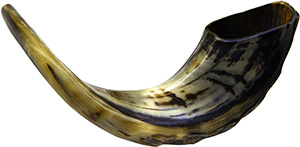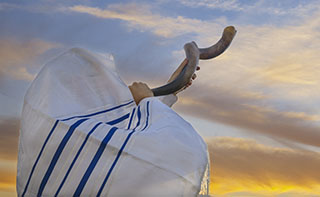 The shofar is a polished ram’s horn used in Jewish services at certain times of the year; in ancient times, it was used to summon everyone in the event of an emergency. It is perhaps one of the strangest among the items used for Jewish ritual. The shofar is basically the horn of a ram that has been smoothed, its appearance and sound evoking the primitive in man. A shofar may be made from the horn of any kosher animal, but custom forbids the use of cow’s horn due to the association of cows with the sin of the golden calf. Although a shofar is most commonly made from the horn of a sheep or goat, more exotic (and sometimes very long) shofarot (the plural of ‘shofar’) are made from the horns of various African animals. Antlers are not used to make a shofar as they cannot be hollowed out, an essential part of the process of turning an animal horn into a shofar.
The shofar is a polished ram’s horn used in Jewish services at certain times of the year; in ancient times, it was used to summon everyone in the event of an emergency. It is perhaps one of the strangest among the items used for Jewish ritual. The shofar is basically the horn of a ram that has been smoothed, its appearance and sound evoking the primitive in man. A shofar may be made from the horn of any kosher animal, but custom forbids the use of cow’s horn due to the association of cows with the sin of the golden calf. Although a shofar is most commonly made from the horn of a sheep or goat, more exotic (and sometimes very long) shofarot (the plural of ‘shofar’) are made from the horns of various African animals. Antlers are not used to make a shofar as they cannot be hollowed out, an essential part of the process of turning an animal horn into a shofar.

Beyond a mechanical act, the blowing of the shofar carries symbolism that calls for further analysis and understanding.
The word shofar is derived from a Hebrew form shfr which implies hollowness. This infers that it is an empty vessel, and that it is only important and useful when the breath of man is blown into it. The shofar thus symbolises the human being on Rosh HaShanah, who is likened to a hollow instrument that is capable of divinity once appropriately filled.
When the shofar is blown, those who hear it heed its call of the past, present and future. It is spiritually uplifting, commanding a deeper level of consciousness and self-awareness.
How to Buy A Shofar

The first place to look for a shofar is locally, in a Jewish bookstore. If there is no Jewish bookstore in proximity, ask your local rabbi or Jewish community services office. It is also possible to buy one overseas using the internet and have it delivered. A shofar may not be found all year round. The best time to buy a shofar is during the period leading up to Rosh HaShanah as there will be the widest range available.
A popular alternative is to buy a shofar in Israel if you happen to be visiting there. Judaica shops abound and most have at least a few shofars for sale. Just remember when returning to Australia to declare the shofar to Australian Customs, as a shofar is an animal product. There should be no problem with Australian Customs allowing a shofar into the country provided it is declared and was made properly.
The appearance and sound are most important when purchasing a shofar. The exterior should be smooth, without cracks or splits. A shofar with an artificial mouthpiece is not considered genuine, since it is not really amplifying the sound from the horn.
The shofar should be tested for sound before it is bought. The buyer must be able to blow it effectively, since the sound of the shofar is crucial to its use and significance.
Owning your own shofar makes the experience of hearing its sound so much more powerful.
Why Jews blow the shofar
According to the famous Jewish scholar Maimonides, the shofar is blown to commemorate the beginning of the world, during the Days of Awe. It signifies the return to the beginning of time in order to make a new beginning in our own lives.
The medieval scholar Saadia Gaon gave ten reasons as to why Jews blow the shofar. The author Shai Agnon, in his book Days of Awe,cites some of these reasons:
One reason is that Rosh HaShanah marks the beginning of creation, therefore we blow the shofar as a sign of acceptance of the Creator: “With trumpets and sound of the horn shout you before the King the Lord.” (Psalms 98:6).
The shofar is also blown to mark the beginning of teshuvah, in order to warn the people: “Let all who desire to turn in teshuvah, turn now: and if you do not, you will have no reason to cry injustice’” (Agnon; Days of Awe; New York, 1965). Teshuvah is done in the ten days that fall between New Year and the Day of Atonement (Yom Kippur) during which Jewish people are encouraged to return to God and ask for his forgiveness.
Another reason given by Saadia Gaon for the blowing of the shofar is that it serves as a reminder of the time at Mount Sinai, when the ten commandments were given. It is said that the sound of the shofar reminds us of when our forefathers decreed: “We will do and obey” (Exodus 24:7).
The shofar is also blown to remind us of Abraham’s symbolic sacrifice of his son Isaac, and to affirm our own willingness to offer ourselves for the sanctification of God. The sound of the shofar is akin to the call of God, while the willingness to sacrifice shown on the part of Abraham and Isaac is a reminder of the need to listen to and make sacrifices for Him.
Saadia Gaon also stated that we blow the shofar to cause trembling and fear amongst the community, as a reminder of God’s omnipotence: “Shall the horn be blown in a city, and the people not tremble?” (Amos 3:6).
Jews also blow the shofar to mark the gathering of the dispersed people of Israel, and the wish that they may be gathered once more.
According to another tradition, the shofar is blown to confuse Satan, who hates its sound because of all that it represents. It is said that when the Messiah comes and the shofar is sounded, Satan will be completely disoriented.
Blowing the shofar

The blowing of the shofar stems from a verse in Leviticus 25:9: “Then you shall sound the horn loud; in the seventh month, on the tenth day of the month – the Day of Atonement – you shall have the horn sounded throughout your land.”
The word teruah, which is called out during the blowing, means ‘loud’or ‘wailing’. As it is mentioned immediately before shofar in the above verse, it is sounded in between two normal shofar blows. These are called tekiot, or tekiah in singular and are sounded as well; tekiah teruah tekiah!
The Torah orders the blowing of the shofar in three places: Leviticus 25:9, Leviticus 23:24 and Numbers 29:1. Each verse uses the word teruah, which is interpreted to mean that the tekiah truah tekiah sequence is blown three times.
Due to a discrepancy in interpretation of the word teruah and the sound it infers, there are three derived versions of the three-piece sequence. Each version is repeated three times, amounting to a total of 30 calls.
There is the ululation, resulting in a high-pitched howl sound, which is simply called ‘teruah’ or ‘wailing’. Another is the loud groan, repeated three times, and called the ‘shevarim’. Others prefer a combination of both, namely the ‘shevarim-teruah’. To cease any further confusion an agreement was reached to combine all three in the service.
The Tekiat Shofar, or ‘Order of the Blowing of the Shofar’ commences after the Torah and Haftarah have been read on Rosh HaShanah. Verses from Psalms are recited and the shofar-blower makes two blessings. The shofar is hidden in the tallit of the shofar-blower until it is time to blow.
There is a designated caller who calls out tekiah, which is followed by a blow, shevarim teruah and then tekiah.This is repeated three times, followed by the next round of tekiah shevarim tekiah. At the very end of the last cycle, the tekiah teruah tekiah, the caller calls out tekiah gedolah – large blow – for the last tekiah. This is ensued by more recitals from Psalms.
The Torah scrolls are then returned to the ark and Musaf begins, including three special sections: Malkhuyot – Kingships, affirming God’s sovereignty, Zikhronot – Remembrances, in reference to the forefathers and the covenant God made with them, and Shofarot – Horns, alluding to the sounds heard at the giving of the Ten Commandments, and those to be heard when the Messiah arrives. The shofar is blown at the end of each section, according to the custom of the community.
The mitzvah (commandment) of hearing the shofar is fulfilled only if both the blower and the hearer acted (either blowing or hearing the shofar) with the intention of fulfilling the mitzvah. The hearer must display his intention to listen completely by answering “Amen” after the blessings. The blower must think to himself that he intends to fulfill the mitzvah for the listeners.
Although the basic mitzvah of blowing the shofar is fulfilled by hearing nine sounds, or thirty with the three combinations, it is customary to blow the shofar 100 times.
The variations of the order of the soundings and the number of blasts can create confusion, but the central factor of this ritual lies in the hearing and recognising of the sound of mercy that resonates from the shofar.
The video above explains various rules related to the Shofar.
The video above explains the mechanics of how to blow a shofar.


